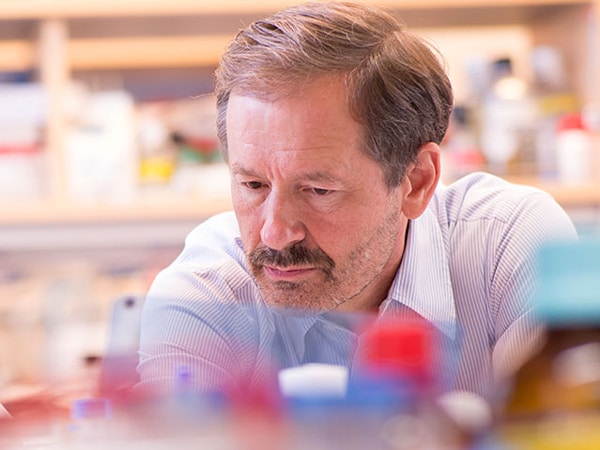Targeting “Undruggable” Proteins That Drive Cancer
An AACR grantee uses chemistry to build “molecules that can go after undruggable protein targets” to treat cancers.
Cancers are often driven by proteins created by specific “oncogenes.” These proteins, when mutated, hijack the machinery of normal cells and cause them to proliferate out of control, creating tumors and potentially spreading through the body.
Drugs aimed at these proteins take advantage of their surface configurations to latch onto them and prevent them from interfering with cells. But some families of proteins lack pockets or crevices on their surfaces that the drugs can use. Attacking them is like climbing up a wall with no footholds; the drugs can’t get a grip.
For decades, these proteins have been considered “undruggable,” but that way of looking at them is changing.
As a graduate student at Harvard University, Raymond E. Moellering, PhD, now a professor in the University of Chicago’s Department of Chemistry, began to work on identifying ways to target undruggable proteins. His work was aided greatly when he earned a grant from the American Association for Cancer Research (AACR).
Research in recent years has shown that the KRAS protein, implicated in many cancer cases, is not “undruggable” after all.
“‘Undruggable’ was a historic term,” said Dr. Moellering in an interview with the AACR. “It’s not a fact. I think the same is going to be true for MYC, and many of the other targets that have been given that title. I think that title will fall.”
As an undergraduate majoring in chemistry at the University of Arizona, he was fascinated by the interplay between chemistry and biology.
“I realized that biology is a kind of fantastic playground for chemistry, where you can use chemistry to spy on what’s happening inside of living systems or to create new chemical probes or therapeutics to try to manipulate those systems,” he said.
At Harvard, he worked on “developing new synthetic methods that will allow pharmacologic access to regions of biological space that are currently considered ‘undruggable.’”
This early focus on the problematic proteins came in his application for a fellowship being offered by the AACR to celebrate the organization’s 2007 centennial. The opportunity was made available to predoctoral students, a departure from the usual practice of funding only scientists who already had their doctoral degrees.
“That grant really catapulted my career,” he said. “It was an early win, and it helped lead to additional funding over the years … and allowed us to work on some risky questions.”
The AACR fellowship supported work that he reported in a paper published in Nature in 2009. Dr. Moellering and his team constructed a synthetic peptide aimed at the cancer-causing protein known as NOTCH1. Experiments indicated encouraging activity in mice with leukemia.
“These observations underscore the mechanistic utility and potential therapeutic value of NOTCH antagonists that act by directly targeting the NOTCH transactivation complex,” they wrote.
Dr. Moellering was able to apply part of his grant to his postdoctoral work at the Scripps Research Institute in La Jolla, California.
At Scripps, he asked whether deregulated metabolism—a driver of tumor growth—could be a viable therapeutic option as well, a line of inquiry that led him to transcription factors (TFs), such as MYC, and other elements of the “biological space” considered undruggable.
“Activation of TFs like MYC is almost uniformly present in cancer,” Dr. Moellering said, “and these proteins and their downstream gene expression programs represent the driving force behind cancer growth.”
He noted that finding a way to inhibit MYC and other transcription factors could deprive tumors of much of their growth potential.
“Doctors have had a hit list of transcription factors for decades, but we have lacked a way to target them,” Dr. Moellering told the University of Chicago news bureau. “This work sets the stage for letting us go directly for any transcription factor.”
Dr. Moellering’s team created synthetic transcriptional repressors (STRs) that latch onto DNA where MYC usually binds to activate pro-growth genes. When the STR gets there first, MYC is blocked out. Even better, STRs can be engineered to bind to other points in the DNA, thus acting against transcription factors besides MYC.
“These findings confirm that the general approach described herein forms a basis for methodical development of sequence-specific synthetic transcriptional repressors for the study and pharmacologic targeting of gene expression regulated by diverse TFs,” they wrote in Nature Biotechnology in late 2022.
Dr. Moellering considers his lab’s work as focused on addressing fundamental challenges at the basic science level, questions that have “direct and important translational applications.”
“How do you find new ways of building molecules that can go after undruggable protein targets that we’ve known for years or even decades are the most important targets in diseases like cancer?” he asked.
“In order to tackle those challenges, you have to go back to basic science and think about structure-function relationships and how to build molecules that have the right properties,” he said. “But if you can then crack those challenges, that can very quickly become translational.”
Looking back, Dr. Moellering said the fellowship given to him as a doctoral candidate encouraged him to work at the interface of chemistry, biology, and cancer, and that this could be an example to both associations and philanthropists offering funding and to students and young researchers planning their careers.
“I really encourage funders and scientists to focus on that interface between fields,” he said. “It’s important to draw more students across boundaries at early stages of their careers, because then they become somewhat bilingual between those fields, and I think they have the greatest opportunity to make large impacts in science.”

